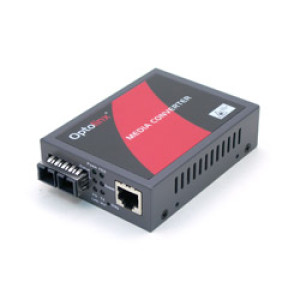Your shopping cart is empty!
MENU

Unified communication is a concept designed to integrate telecommunication services and devices such as VOIP (Voice-over-Internet-Protocol), analog telephone adapters, gateways, and appliances. Media converters, gateways, and extenders are tools that allow you to take the myriad devices, connections, and data lines in your network and put them to a common purpose. They allow you to have fiber optics, standard copper, analog phone lines, and legacy coaxial cables all in one place, working together in harmony. There’s a tool for every job, and manufacturers like Antaira and Patton supply the solutions you need.
A high-quality fiber optic converter significantly expands the range of options in a network design.
To communicate over a fiber-optic network, you’ll need isolators and extenders that are reliable and easy to integrate. A converter like the Patton FiberPlex FOI-5401 puts multiple media methods into your hands with a single device. It works with T1 and can isolate networks, convert signals, and serve as a modem, all at the same time. It is packed with interference protection that minimizes crosstalk, DMI, impulse noise, radiation, and RFI. It stabilizes your voice communications while extending the network range by up to 4,800 feet.
There is a lot of communication infrastructure in the world. Much of it is older and easy to ignore, but failing to use existing resources is a failure to maximize your network’s value. ISDN and T1 isolators and extenders like the FOI-5601 allow you to significantly increase the distance of your existing lines using fiber optics. You can save massively on infrastructure investment without sacrificing quality. These devices are plug-and-play, making the process as easy as possible.
Even when you use VoIP, many facilities need to incorporate legacy devices. To integrate legacy telephone equipment with new digital resources, analog phone converters are essential. The SN200 telephone adapter and VOIP gateway is a perfect example. It supports multiple analog FXS lines, PoE connections, and can handle up to four simultaneous calls. It’s a cost-effective way to integrate your legacy phones, and it works with fax and metering.
When work has to span great distances, you need innovative solutions to keep costs under control. For high-speed networking, Ethernet extenders are a pivotal device that can convert existing copper lines into modern networks. Industrial extenders that work with Plain Old Telephone Service (POTS) or coaxial cables are an excellent way to reuse existing infrastructure. The converters can handle both voice and data transmissions simultaneously. They are perfect for video on demand, voice over IP, video phones, and IPTV.
If you have or plan to use traditional copper infrastructure, Ethernet over VDSL2 is the obvious way to extend your hard lines. The EVC-3101 converter from Antaira Technologies uses RJ11 POTS to connect Fast Ethernet (10/100TX) devices to phone lines. Using existing lines can increase your network range without the cost of cabling or the workforce required to install it. Transfer rates of up to 160 Mbps upload and 200 Mbps download through your phone line, supporting symmetric data transmission, can accommodate multimedia services. The converter can also run signals over POTS. It’s a plug-and-play device with a master/slave switch. It can run optimally on lines up to 300 meters, making it an excellent tool for customizing your network to make the most of what is already there.
When RJ11 isn’t the preferred connection, you can turn to a media converter to supply Ethernet over coaxial. Certain products can support 50 ohm or 75 ohm cables and achieve the fastest data rates possible without a complete rewiring. When you need digital performance from analog systems, this is easily one of the most cost-saving approaches available.
Digital VoIP gateways will form the backbone of your phone communications. Patton Electronics manufactures the SmartNode SN4140E, a rugged gateway designed for use in outdoor or harsh environments. It can be vehicle-mounted for mobile operations. It is even rated for military use in combat zones. Your VoIP Gateway facilitates both analog and digital communications, ensuring reliable voice wherever it is needed.
These telephony converters and gateways are a small piece of the grand puzzle that is your industrial network. When you need experts who can help sort through all of the pieces, call Westward Sales. We have the equipment and expertise to answer your communications problems.